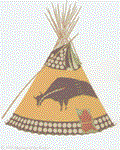Blackfeet Indian Tipis Serigraphs Design and Legends
 Blackfeet Indian Tipis: Design and Legend, Fine Arts Collections, Museum of the Rockies, Bozeman, Montana
Blackfeet Indian Tipis: Design and Legend, Fine Arts Collections, Museum of the Rockies, Bozeman, Montana
The painted tipi was formerly an important traditional art form among most Plains Indian tribes; but with the destruction of the great buffalo herds in the latter part of the 19th century, and the change from buffalo cow-hide tipis to canvas tipis, the tradition died out except among the Blackfeet Indians.
These tipis were of religious significance, being a part of a complex of sacred objects and rituals and taboos surrounding the Indian owners as long as they possessed the tipis. According to the origin legends relating how each painted tipi was acquired by its first owner, many painted tipis were given to their first Indian owners in dreams or visions.
The twenty-six tipis shown here were observed at one or another of the encampments on the Blackfeet or Blood Reserves in 1944 or 45, at the time of the annual Sun Dance early in July. Grouped in a large circle, with their doorways facing the east and the rising sun, and their backs made steeper to brace the structures against the prevailing west winds, they made an impressive sight on the low sweeping hills of northwestern Montana and southern Alberta, with the Northern Rockies rising in the distance.
In producing the silk-screened plates for this collection, every effort has been made to show the tipis as they were in the mid-1940s when the data was collected. The names of the owners, printed on the back of each plate, are also as authentic as it has been possible to make them.
The Blackfeet Indian Tipis: Design and Legend Project was started by Olga Ross Hannon in 1944. It was revived and completed for the Museum of the Rockies in 1974-76, and funded in part, by a grant from the Montana Arts Council, an agency of Montana State government.
